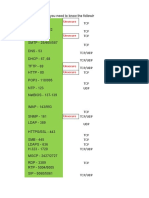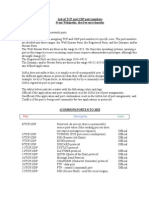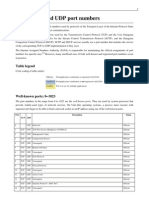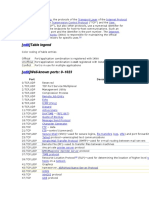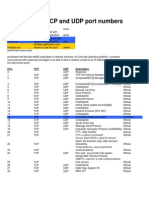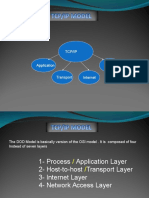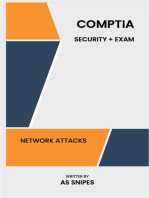50 Common Ports You Should Know
50 Common Ports You Should Know
Uploaded by
Alan VestaCopyright:
Available Formats
50 Common Ports You Should Know
50 Common Ports You Should Know
Uploaded by
Alan VestaCopyright
Available Formats
Share this document
Did you find this document useful?
Is this content inappropriate?
Copyright:
Available Formats
50 Common Ports You Should Know
50 Common Ports You Should Know
Uploaded by
Alan VestaCopyright:
Available Formats
1
50+ Common Ports You Should Know
•
Port•• number is a 16-bit numerical value that ranges from 0 to 65535. Well-known port (0-1023),
registered port (1024-49151), and dynamic port is three types of port number space. (49152-
65535).
These ports can be opened and used by software applications and operating system services to
send and receive data over networks (LAN or WAN) that employ certain protocols (eg TCP, UDP).
For example, we use 80 for HTTP-web-based plain-text surfing and 443 for HTTPS-web-based
encrypted websites in our daily work.
To conclude, a port is a logical form to identify system activities or various network services used
to create local or network-based communications.
What are the functions of ports?
When interacting over the Internet, TCP and UDP protocols make connections, recompile data
packages after the transfer, and then deliver them to applications on the recipient’s device. For
this handover to work, the operating system must install and open the gateway for the transfer.
Each door has a unique code number. After transmission, the receiving system uses the port
number to determine where the data should be sent. The port numbers of the sender and
receiver are always included in the data packet.
Ports are assigned sequential numbers from 0 to 65535. Some of these codes are standardized,
meaning they are assigned to certain uses. Since code numbers are universally recognized and
permanently assigned, these standard ports are also known as well-known ports. Registered
ports are those that organizations or software developers have registered for their applications.
Registration is handled by the Internet Assigned Numbers Authority (IANA). A diverse selection
of dynamically assigned port numbers is also available. For example, when viewing websites,
browsers use these ports. After that, the phone number is free again.
Why is it important to know these ports?
Any security researcher, bug bounty hunter, or anyone working with service configuration would
benefit from this. Knowing how to do more thorough scans such as version detection or known
vulnerabilities for ancient services that are still operating in the infrastructure, especially when
using tools like Nmap, is handy when getting to know these protocols and services.
2
The most 50 significant ports are listed here:
The following are some of the most common service names, transport protocol names, and port
numbers used to differentiate between specific services that employ TCP, UDP, DCCP, and SCTP.
Port Service Transport
Number name protocol Description
7 Echo TCP, UDP Echo service
20 FTP-data TCP, SCTP File Transfer Protocol data transfer
TCP, UDP,
FTP File Transfer Protocol (FTP) control connection
21 SCTP
TCP, UDP, Secure Shell, secure logins, file transfers (scp, sftp),
SSH-SCP
22 SCTP and port forwarding
23 Telnet TCP Telnet protocol—unencrypted text communications
Simple Mail Transfer Protocol, used for email
SMTP TCP
25 routing between mail servers
53 DNS TCP, UDP Domain Name System name resolver
69 TFTP UDP Trivial File Transfer Protocol
Hypertext Transfer Protocol (HTTP) uses TCP in
versions 1.x and 2.
TCP, UDP,
HTTP
SCTP HTTP/3 uses QUIC, a transport protocol on top of
UDP
80
88 Kerberos TCP, UDP Network authentication system
ISO Transport Service Access Point (TSAP) Class 0
Iso-tsap TCP
102 protocol
110 POP3 TCP Post Office Protocol, version 3 (POP3)
3
Port Service Transport
Number name protocol Description
Microsoft EPMAP (End Point Mapper), also known
Microsoft as DCE/RPC Locator service, used to remotely
TCP, UDP
EPMAP manage services including DHCP server, DNS
135 server, and WINS. Also used by DCOM
NetBIOS Name Service, used for name registration
NetBIOS-ns TCP, UDP
137 and resolution
139 NetBIOS-ssn TCP, UDP NetBIOS Session Service
Internet Message Access Protocol (IMAP),
IMAP4 TCP, UDP
143 management of electronic mail messages on a server
381 HP Openview TCP, UDP HP data alarm manager
383 HP Openview TCP, UDP HP performance data collector.
default port for the Lightweight Directory Access
LDAP UDP Protocol (LDAP). It is used for accessing and
389 maintaining directory services.
Hypertext Transfer Protocol Secure (HTTPS) uses
HTTP over TCP, UDP,
TCP in versions 1.x and 2. HTTP/3 uses QUIC, a
SSL SCTP
443 transport protocol on top of UDP.
464 Kerberos TCP, UDP Kerberos Change/Set password
SMTP over
Authenticated SMTP over TLS/SSL (SMTPS), URL
TLS/SSL, TCP
Rendezvous Directory for SSM (Cisco protocol)
465 SSM
587 SMTP TCP Email message submission
HTTP RPC Ep Map, Remote procedure call over
Microsoft Hypertext Transfer Protocol, often used by
TCP, UDP
DCOM Distributed Component Object Model services and
593 Microsoft Exchange Server
4
Port Service Transport
Number name protocol Description
LDAP over Lightweight Directory Access Protocol over
TCP, UDP
636 TLS/SSL TLS/SSL
691 MS Exchange TCP MS Exchange Routing
VMware
unofficial VMware ESXi
902 Server
989 FTP over SSL TCP, UDP FTPS Protocol (data), FTP over TLS/SSL
990 FTP over SSL TCP, UDP FTPS Protocol (control), FTP over TLS/SSL
IMAP4 over Internet Message Access Protocol over TLS/SSL
TCP
993 SSL (IMAPS)
POP3 over
TCP, UDP Post Office Protocol 3 over TLS/SSL
995 SSL
Microsoft operating systems tend to allocate one or
more unsuspected, publicly exposed services
Microsoft RPC TCP (probably DCOM, but who knows) among the first
handful of ports immediately above the end of the
1025 service port range (1024+).
1194 OpenVPN TCP, UDP OpenVPN
1337 WASTE unofficial WASTE Encrypted File Sharing Program
1433 SQL Server TCP Microsoft SQL Server
1589 Cisco VQP TCP, UDP Cisco VLAN Query Protocol (VQP)
1725 Steam UDP Valve Steam Client uses port 1725
2082 cPanel unofficial cPanel default
5
Port Service Transport
Number name protocol Description
Secure RADIUS Service (radsec), cPanel default
radsec, cPanel TCP, UDP
2083 SSL
Oracle database listening for insecure client
Oracle DB TCP, UDP
2483 connections to the listener, replaces port 1521
Oracle database listening for SSL client connections
Oracle DB TCP, UDP
2484 to the listener
2967 Symantec AV TCP, UDP Symantec System Center agent (SSC-AGENT)
3074 XBOX Live TCP, UDP Xbox LIVE and Games for Windows – Live
3306 MySQL TCP MySQL database system
World of Some Blizzard games, Unofficial Club Penguin
TCP, UDP
3724 Warcraft Disney online game for kids
Google
unofficial Google Desktop Search
4664 Desktop
5432 PostgreSQL TCP PostgreSQL database system
RFB/VNC virtual Network Computing (VNC) Remote Frame
TCP, UDP
5900 Server Buffer RFB protocol
6665-6669 IRC TCP Internet Relay Chat .
BitTorrent is part of the full range of ports used most
BitTorrent unofficial
6881 often
BitTorrent is part of the full range of ports used most
BitTorrent unofficial
6999 often
6970 Quicktime unofficial QuickTime Streaming Server
6
Port Service Transport
Number name protocol Description
8086 Kaspersky AV TCP Kaspersky AV Control Center
8087 Kaspersky AV UDP Kaspersky AV Control Center
VMware VMware Server Management User Interface
TCP, UDP
8222 Server (insecure Web interface).
PDL Data Stream, used for printing to certain
PDL TCP
9100 network printers.
Webmin, Web-based Unix/Linux system
BackupExec unofficial
10000 administration tool (default port)
NetBus remote administration tool (often Trojan
NetBus unofficial
12345 horse).
27374 Sub7 unofficial Sub7 default
31337 Back Orifice unofficial Back Orifice 2000 remote administration tools
You might also like
- Costing Sheet Excel FormatDocument2 pagesCosting Sheet Excel FormatDeny Arisandi50% (4)
- List of TCP and UDP Port Numbers (Common) Ports 0 To 1023Document9 pagesList of TCP and UDP Port Numbers (Common) Ports 0 To 1023Hà GiangNo ratings yet
- Common Ports Cheat SheetDocument10 pagesCommon Ports Cheat Sheetsharaf jaberNo ratings yet
- Network+ Common PortsDocument2 pagesNetwork+ Common PortsNeil EidelNo ratings yet
- List of TCP and UDP Port NumbersDocument30 pagesList of TCP and UDP Port NumbersRobert J. WilliamsNo ratings yet
- List of TCP and UDP Port NumbersDocument27 pagesList of TCP and UDP Port Numbersscribd_bharatNo ratings yet
- List of TCP and UDP Port NumbersDocument32 pagesList of TCP and UDP Port NumbersKartik NaiduNo ratings yet
- JHS-770 Software Upgrade ProcedureDocument19 pagesJHS-770 Software Upgrade ProcedureGOGO COllZZss100% (2)
- Prepare AppetizerDocument64 pagesPrepare AppetizerAliyah Place100% (5)
- Ports and ProtocolsDocument12 pagesPorts and ProtocolsDavid JosephNo ratings yet
- Network Ports ReferenceDocument5 pagesNetwork Ports ReferenceMoustaphaNo ratings yet
- 50 Common Ports You Should Know - GeeksforGeeksDocument4 pages50 Common Ports You Should Know - GeeksforGeeksveewhyte51No ratings yet
- Port NumberDocument9 pagesPort NumberAvik MazumdarNo ratings yet
- 50 Common Ports You Should Know - GeeksforGeeksDocument12 pages50 Common Ports You Should Know - GeeksforGeeksPérez Flores IvonneNo ratings yet
- TCP-UDP Ports LIst-2Document14 pagesTCP-UDP Ports LIst-2Giuseppe IndennitateNo ratings yet
- Network Ports and ProtocolsDocument1 pageNetwork Ports and Protocolsapi-371092170No ratings yet
- Database AssignmentDocument2 pagesDatabase AssignmentNdebueze DamianNo ratings yet
- 11 - TCPIP Transport Layer ProtocolsDocument11 pages11 - TCPIP Transport Layer ProtocolsRaenel Carolino MananganNo ratings yet
- Cyberkraft Security Ports and Protocols Reference Sheet SY0 701Document3 pagesCyberkraft Security Ports and Protocols Reference Sheet SY0 701Oscar DesiderioNo ratings yet
- List of TCP and UDP Port NumbersDocument31 pagesList of TCP and UDP Port NumbersAlex MartinezNo ratings yet
- Port and ProtocolDocument8 pagesPort and ProtocolRamin MohammadiNo ratings yet
- Protokolle WellknownportsDocument1 pageProtokolle WellknownportsDominik GeierNo ratings yet
- Port Numbers and FunctionsDocument27 pagesPort Numbers and Functionsdmbowie89No ratings yet
- Network Protocol and Service PortsDocument5 pagesNetwork Protocol and Service Portsberna1127No ratings yet
- NW Lec 4Document51 pagesNW Lec 4omarnader16No ratings yet
- Port NumbersDocument32 pagesPort NumbersShailendra MathurNo ratings yet
- Well Known Ports WikiDocument5 pagesWell Known Ports WikiZubair AliNo ratings yet
- Aelphi - Network 03 TCP Ip ModelDocument1 pageAelphi - Network 03 TCP Ip ModelSergeo ArmaniNo ratings yet
- 1-4 TCP-IP ModelDocument4 pages1-4 TCP-IP ModelDragan StančevNo ratings yet
- Fundaments of NetworkingDocument53 pagesFundaments of Networkingrkjadhav1453No ratings yet
- SocketDocument5 pagesSocketshindedivyeshavinashNo ratings yet
- List of TCP and UDP Port NumbersDocument38 pagesList of TCP and UDP Port NumbersHamdi KadriNo ratings yet
- List of TCP and UDP Port Numbers PDFDocument42 pagesList of TCP and UDP Port Numbers PDFAbhjijit ChandraNo ratings yet
- Network+ Study GuideDocument51 pagesNetwork+ Study Guiderseara1127No ratings yet
- Computer Networks: Tcp/Ip: University of JubaDocument68 pagesComputer Networks: Tcp/Ip: University of JubaMabor BolNo ratings yet
- List of TCP and UDP Port NumbersDocument63 pagesList of TCP and UDP Port NumberssaidurgaNo ratings yet
- ARC EngDocument28 pagesARC EngmariagodeanuNo ratings yet
- 04 TCP IP ModelDocument35 pages04 TCP IP ModelWayne WayneNo ratings yet
- List of TCP and UDP Port Numbers - Wikipedia, The Free EncyclopediaDocument54 pagesList of TCP and UDP Port Numbers - Wikipedia, The Free EncyclopediaSrđan TufegdžićNo ratings yet
- Bab6 DikompresiDocument40 pagesBab6 DikompresiAdi Ahmad FauziNo ratings yet
- Lab12 Netw Forensics Data HidingDocument17 pagesLab12 Netw Forensics Data HidingLêDương AnhTuấnNo ratings yet
- Network ProtocolsDocument39 pagesNetwork ProtocolsabdrheemsultanNo ratings yet
- List of TCP and UDP PortsDocument8 pagesList of TCP and UDP PortsEl Patron 1No ratings yet
- Port# TCP or UDP Port Name DescriptionDocument1 pagePort# TCP or UDP Port Name DescriptionMalluNo ratings yet
- TCP-IP Full SlidesDocument106 pagesTCP-IP Full SlidesmehdiNo ratings yet
- TCP Port Service Multiplexer: Active UsersDocument18 pagesTCP Port Service Multiplexer: Active UsersSbroth01No ratings yet
- Listado Puertos TCP UdpDocument26 pagesListado Puertos TCP Udpelio320No ratings yet
- ViberSAT QoSDocument14 pagesViberSAT QoSMannyNo ratings yet
- CEH Module 8Document76 pagesCEH Module 8amandalire43No ratings yet
- Selecontrol® Mas: Tcp/Ip and UdpDocument26 pagesSelecontrol® Mas: Tcp/Ip and UdpM. Andri Ludfi FananiNo ratings yet
- List of TCP and UDP Port NumbersDocument32 pagesList of TCP and UDP Port NumbersnoordmoNo ratings yet
- 4 Protokol PengalamatanDocument44 pages4 Protokol Pengalamatananon_615742149No ratings yet
- Siem VijayaaDocument35 pagesSiem VijayaanagarjunaNo ratings yet
- TCP vs. Udp: October 2015Document10 pagesTCP vs. Udp: October 2015Kashif ManzoorNo ratings yet
- Tugas Komunikasi DataDocument3 pagesTugas Komunikasi DataEdunkNo ratings yet
- List of TCP and UDP Port NumbersDocument33 pagesList of TCP and UDP Port NumbersDanilo Henrique AchcarNo ratings yet
- ProtocolsDocument3 pagesProtocolsDavid OwnerNo ratings yet
- List of All PortsDocument66 pagesList of All PortsAkibo Tunde Williamson DaviesNo ratings yet
- Data CommunicationsDocument4 pagesData CommunicationsAtiqurRahmanNo ratings yet
- TCP IP ModelDocument13 pagesTCP IP ModelDevakumarNo ratings yet
- TCPDocument39 pagesTCPErnesto OrtizNo ratings yet
- Hacking Network Protocols: Unlocking the Secrets of Network Protocol AnalysisFrom EverandHacking Network Protocols: Unlocking the Secrets of Network Protocol AnalysisNo ratings yet
- What Is Your Name? 2. How Old Are You?: 5. What Type of Phone Do You Have (Form Factor) ?Document3 pagesWhat Is Your Name? 2. How Old Are You?: 5. What Type of Phone Do You Have (Form Factor) ?Nikhil Singhal100% (1)
- Fire Terminology 5Document3 pagesFire Terminology 5Fire LibraryNo ratings yet
- Bruce Swedien TipsDocument9 pagesBruce Swedien Tipsrjpfunk100% (1)
- UHGBVFCDXSDocument3 pagesUHGBVFCDXSRAFAELLA SOTO PONCENo ratings yet
- 2011 Wilson Combat CatalogDocument48 pages2011 Wilson Combat CatalogMario Lopez100% (1)
- Earl Lenmeyer The Flask-1Document2 pagesEarl Lenmeyer The Flask-1Lorena Monterrosas Pérez100% (1)
- Bfi Statistical Yearbook 2021-10-05Document229 pagesBfi Statistical Yearbook 2021-10-05Taio RogersNo ratings yet
- Magagnini Antonella 2ndaDocument3 pagesMagagnini Antonella 2ndaAntonella MagagniniNo ratings yet
- Marketing Plan ClarenceDocument10 pagesMarketing Plan ClarenceAramae Quindoza BiloloNo ratings yet
- Result Clauses PracticeDocument7 pagesResult Clauses Practicelsandia93No ratings yet
- Question 1: Do You Like Watching Films?Document6 pagesQuestion 1: Do You Like Watching Films?Phước AnNo ratings yet
- TSR 9454 Wizard's Challenge IIDocument36 pagesTSR 9454 Wizard's Challenge IIJannNo ratings yet
- Century Photo CatalogDocument56 pagesCentury Photo Catalogvwsung18t100% (1)
- 0415CClowres PDFDocument64 pages0415CClowres PDFGCMediaNo ratings yet
- Tomb of The Mummy PriestDocument7 pagesTomb of The Mummy PriestKaiser Julianus ApostataNo ratings yet
- Soal Tenses Bahasa InggrisDocument5 pagesSoal Tenses Bahasa InggrisMuh Taufiqur RahmanNo ratings yet
- MK60 Wiring Plan Abs E46m3Document1 pageMK60 Wiring Plan Abs E46m3Denis DenkovNo ratings yet
- Film Language: Film Form and Meaning: (Notes On How To Analyse A Film by Geetha Bakilapadavu)Document21 pagesFilm Language: Film Form and Meaning: (Notes On How To Analyse A Film by Geetha Bakilapadavu)VikramNo ratings yet
- Activity Sheet Reading and WritingDocument3 pagesActivity Sheet Reading and Writingbammy orquiaNo ratings yet
- Probability QuestionDocument4 pagesProbability QuestionChanpreet SinghNo ratings yet
- Active and Inactive List of VolcanoesDocument5 pagesActive and Inactive List of VolcanoesGRascia Ona100% (3)
- Prototype of Wheel Chair Attachable E Hand BikeDocument7 pagesPrototype of Wheel Chair Attachable E Hand BikePAVIN ENGG0% (1)
- SportswearDocument43 pagesSportswearvivek jangraNo ratings yet
- Rephrasing 2nd BachDocument4 pagesRephrasing 2nd BachMistah KurtzNo ratings yet
- MT 101 Chapter 4Document4 pagesMT 101 Chapter 4Fherry AlarcioNo ratings yet
- Fashion QuizDocument2 pagesFashion QuizSol CiNo ratings yet
- The Young Talent of Tomorrow Fashion Design Competition BriefDocument2 pagesThe Young Talent of Tomorrow Fashion Design Competition BriefNana Barnett QuaicooNo ratings yet



